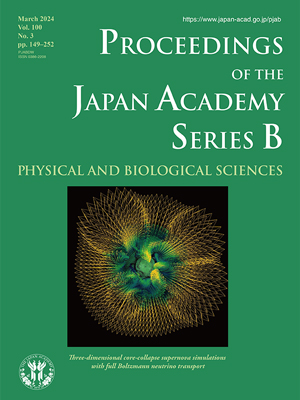About the Cover
Vol. 100 No. 3 (2024)
One of the lingering mysteries in astrophysics is why and how a massive star explodes at the end of its life as a core-collapse supernova (CCSN). Unfortunately, this question is not well understood through observations, mainly due to the lack of neutrino detections (except for one CCSN event: SN1987A) and of gravitational waves, which are the only two information carriers that enable us to peer into the inner dynamics of CCSN. The next nearby (or Galactic) CCSN is expected to occur within decades, and data obtained by observing it will provide precious details of CCSN dynamics by comparing the data with theoretical models.
Theoretical studies of CCSN have made remarkable progress through the multidecade efforts of the community. Yamada and his collaborators have proposed realistic CCSN models by developing numerical simulations using a unique approach (refer to the review article in this issue, pp. 190–233). The governing equations for CCSN comprise macrophysical (e.g., hydrodynamics) and microphysical processes (e.g., neutrino–matter interactions). However, self-consistent treatments of these processes require large-scale numerical simulations in which the primary computational burden is neutrino transport. The basic equation is given by the Boltzmann equation, which is a fundamentally seven-dimensional (one in time, three in space, and three in momentum space) problem. Yamada’s group has worked on the development of a first-principles neutrino-transport scheme—a full Boltzmann neutrino-transport code—for decades, while no other groups could successfully implement a Boltzmann solver into CCSN codes for multidimensional treatments. This means that the CCSN models developed by Yamada’s group can inspect detailed physical processes in the inner engine of a CCSN explosion, which other CCSN codes cannot access.
One of the remarkable achievements in recent works by Yamada’s group is perfoming spatially three-dimensional CCSN simulations with full Boltzmann neutrino transport. The figure demonstrates the results of one of these simulations, which displays a neutrino radiation field (neutrino fluxes) at a given time snapshot during the development of CCSN explosion. Color represents the flux factor, i.e., the ratio of the flux density to the number density, of electron-type neutrinos. This study revealed that the neutrino radiation field becomes highly distorted due to fluid instabilities (e.g., convections), which are qualitatively different from CCSN models that assume spherical or axial symmetry. Furthermore, this work revealed that some of the intrinsic properties of neutrino radiation fields are qualitatively different from those obtained using approximate transport methods. Thus, the results of these studies offer fundamental data that can be used to improve other approximate neutrino-transport schemes. This will render other CCSN models that employ approximate neutrino transport more realistic and will contribute considerably to CCSN research.
Hideyuki Suzuki
Professor, Faculty of Science and Technology, Tokyo University of Science




